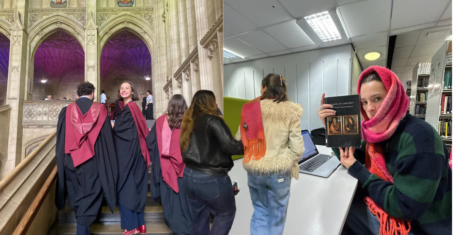
Who’s who? Your guide to the SNP leadership race
Can’t name a Scottish politician? We got you
It’s the end of an era. Nicola Sturgeon – whose voice we became so familiar with during the pandemic when she would make daily decisions on when, where and why we could go to the pub – has resigned as Scotland’s First Minister.
Attention now turns to who will take over as the Scottish National Party (SNP) leader at the end of March. And don’t worry, if (like most Edinburgh University students) you can’t name a single Scottish politician other than Sturgeon, we’ve got you covered.
Here’s your ultimate guide to what happens next, and who is in the running to lead Scotland.
Students at Russell Group University of Edinburgh cannot name a single Scottish politician (beyond Sturgeon) pic.twitter.com/aD4Um7qebs
— Noa Hoffman (@hoffman_noa) February 18, 2023
First Minister is Scotland’s equivalent of a Prime Minister, only with less power. They can make decisions in areas such as health and education, but not on foreign policy or immigration.
The leader of whichever party wins the most seats in the Scottish Parliament at Holyrood (elections happen every five years) becomes First Minister. Simple!
Since the SNP have the most seats in the Scottish Parliament, whoever is elected as their leader will automatically become First Minister too. Three candidates have met the threshold to be included in the contest, which is ultimately decided by the SNP’s approximately 104,000 members.
Kate Forbes

via Instagram @kate_forbes_msp
Kate Forbes is currently the frontrunner in the race, and whose campaign has generated some controversy in recent weeks.
She was elected to the Scottish Parliament in 2016, working her way up to become one of the most senior members of the government in 2020 – finance secretary, in charge of Scotland’s budget.
Most Read
Polling for The Sunday Times has put Forbes ahead of her rivals on 23 per cent.
However, her campaign has had some difficulty among the SNP’s progressive young supporters, after she said she did not support same-sex marriage for religious reasons. Forbes also said she would have voted against the SNP’s recent reforms to gender recognition laws (she didn’t attend the vote), and that she feels it is wrong to have sex outside marriage.
But, she claims she would not seek to “‘row back on rights that already exist” if elected leader, including on equal marriage.
Kate Forbes was at Sturgeon’s side through the difficult days of the pandemic, and aims to continue her mission to secure Scottish Independence, promising in her campaign video to “lead the party into better days”.
With socially conservative views, some commentators believe Forbes winning the race could jeopardise the SNP’s partnership with the Scottish Greens, who are progressive on issues of sex and gender.
Humza Yousaf

via Instagram @humzayousaf
In contrast, Humza Yousaf is more popular among left-wing SNP members, and has made clear he is “firmly committed to equality for everybody, because your rights are my rights regardless of who you are”.
He is seen by some as the closest to Sturgeon of the candidates, because he supports her positions on same-sex marriage, gender recognition reform, buffer zones for abortion centres, and banning conversion therapy.
He was elected to parliament in 2011, making him the longest-serving candidate of the three.
Currently working as Scottish Health Secretary, he has faced criticism from fellow politicians and the public throughout his time in the job. One of the biggest critiques is Scotland’s hospital waiting times, with the Scottish Conservative shadow health secretary, Dr Sandesh Gulhane, stating that the current figures are a “ticking timebomb”.
Yousaf also faced calls to resign during the pandemic when we went on holiday in the week that the World Health Organisation found that Scotland had six out of ten of Europe’s Covid hotspots in July of 2021. He defended the trip to London because “my family don’t see me much at all”, particularly during that busy time.
Ash Regan

via YouTube
Last up, Ash Regan supports achieving Scottish independence by winning more elections for the SNP, not through a direct referendum.
The most recent poll suggests she is unlikely to win the contest, with just seven per cent support among members.
In a speech she outlined her approach to the race, with a campaign built on “hope, optimism, and a belief in the power of our people”, believing that she is “ready to take on this challenge and to lead our party forward towards a brighter future.”
Regan was elected to the Scottish Parliament in 2016, defeating the then Leader of the Scottish Labour party Kezia Dugdale in her constituency.
She served as Community Safety Minister for the SNP until 2022 when she resigned in protest of the government’s reforms to gender recognition, a policy that she strongly opposes.
She also wants to move away from the governments descaling of the oil and gas extraction in the North Sea, which is different from the SNP’s current work as well as the Scottish Green Party’s commitments.
So, what happens now?
The candidates will now be put to a vote among SNP party members. Voting will start on March 13th, and the winner will be announced when voting closes on March 27th.
Fancy keeping up with the race in the coming weeks? There will be a leadership debate airing on STV on the 7th of March at 9 pm, where the candidates will be cross-examined in what promises to be a lively moment in the contest.
Related stories recommended by this writer:
• What we learn from listening to Edinburgh University’s state school students
• Russian societies around the UK call on students to speak out against war in Ukraine
• Over 10,000 Scottish students denied university accommodation each year
















